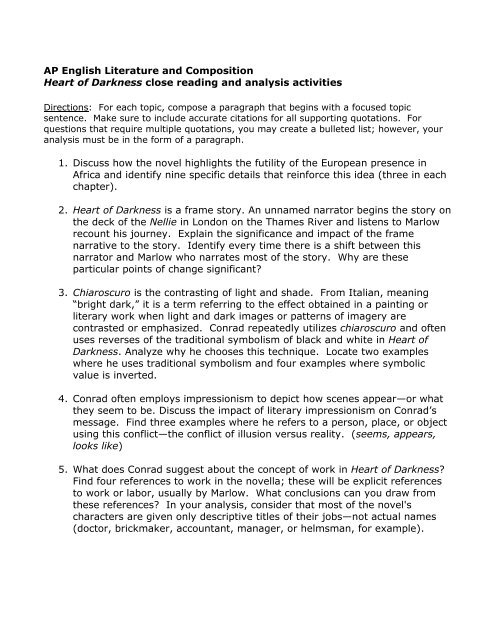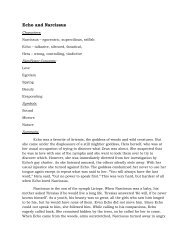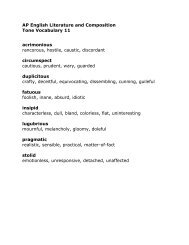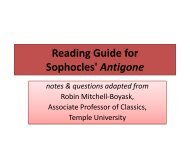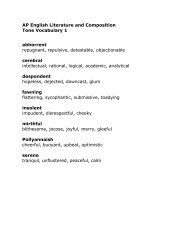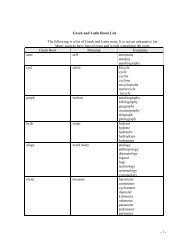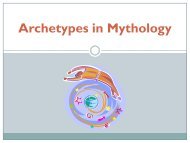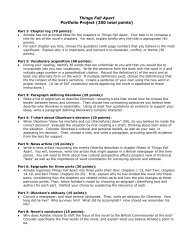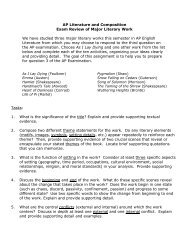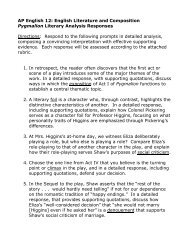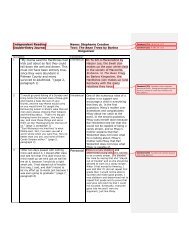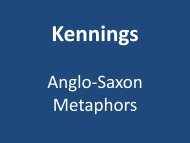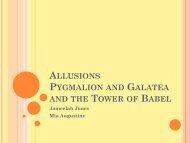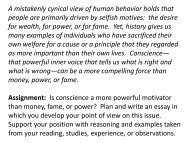AP English Literature and Composition
AP English Literature and Composition
AP English Literature and Composition
Create successful ePaper yourself
Turn your PDF publications into a flip-book with our unique Google optimized e-Paper software.
<strong>AP</strong> <strong>English</strong> <strong>Literature</strong> <strong>and</strong> <strong>Composition</strong><br />
Heart of Darkness close reading <strong>and</strong> analysis activities<br />
Directions: For each topic, compose a paragraph that begins with a focused topic<br />
sentence. Make sure to include accurate citations for all supporting quotations. For<br />
questions that require multiple quotations, you may create a bulleted list; however, your<br />
analysis must be in the form of a paragraph.<br />
1. Discuss how the novel highlights the futility of the European presence in<br />
Africa <strong>and</strong> identify nine specific details that reinforce this idea (three in each<br />
chapter).<br />
2. Heart of Darkness is a frame story. An unnamed narrator begins the story on<br />
the deck of the Nellie in London on the Thames River <strong>and</strong> listens to Marlow<br />
recount his journey. Explain the significance <strong>and</strong> impact of the frame<br />
narrative to the story. Identify every time there is a shift between this<br />
narrator <strong>and</strong> Marlow who narrates most of the story. Why are these<br />
particular points of change significant<br />
3. Chiaroscuro is the contrasting of light <strong>and</strong> shade. From Italian, meaning<br />
“bright dark,” it is a term referring to the effect obtained in a painting or<br />
literary work when light <strong>and</strong> dark images or patterns of imagery are<br />
contrasted or emphasized. Conrad repeatedly utilizes chiaroscuro <strong>and</strong> often<br />
uses reverses of the traditional symbolism of black <strong>and</strong> white in Heart of<br />
Darkness. Analyze why he chooses this technique. Locate two examples<br />
where he uses traditional symbolism <strong>and</strong> four examples where symbolic<br />
value is inverted.<br />
4. Conrad often employs impressionism to depict how scenes appear—or what<br />
they seem to be. Discuss the impact of literary impressionism on Conrad’s<br />
message. Find three examples where he refers to a person, place, or object<br />
using this conflict—the conflict of illusion versus reality. (seems, appears,<br />
looks like)<br />
5. What does Conrad suggest about the concept of work in Heart of Darkness<br />
Find four references to work in the novella; these will be explicit references<br />
to work or labor, usually by Marlow. What conclusions can you draw from<br />
these references In your analysis, consider that most of the novel's<br />
characters are given only descriptive titles of their jobs—not actual names<br />
(doctor, brickmaker, accountant, manager, or helmsman, for example).
6. Nigerian novelist, Chinua Achebe (author of Things Fall Apart), in a lecture at<br />
the University of Massachusetts, attacked Heart of Darkness as “racist”:<br />
[Conrad] projects the image of Africa as “the other world,”<br />
the antithesis of Europe <strong>and</strong> therefore of civilization, a place<br />
where man’s vaulted intelligence <strong>and</strong> refinement are finally<br />
mocked by triumphant bestiality . . . . Conrad is a purveyor<br />
of comforting myths (<strong>and</strong>) a bloody racist . . . . That this<br />
simple truth is glossed over in criticisms of his work is due to<br />
the fact that white racism against Africa is such a normal way<br />
of thinking that its manifestations go completely undetected.<br />
Find three specific points that you would use to defend this<br />
statement <strong>and</strong> three specific references that you would use to<br />
refute this statement.<br />
7. Invent titles for each of the three chapters, <strong>and</strong> provide a brief<br />
defense for each of your titles. Make sure that you explain how<br />
these titles relate to the novella title <strong>and</strong> provide specific textual<br />
support.<br />
8. Freud divided the human psyche (mind, personality, self, or soul)<br />
into three parts: the superego, the ego, <strong>and</strong> the id. As Marlow<br />
travels to Africa <strong>and</strong> down the Congo River, he also travels<br />
psychologically from superego to id.<br />
Superego:<br />
o externally imposed st<strong>and</strong>ards <strong>and</strong> regulations that humans live by<br />
(customs, laws, mores, st<strong>and</strong>ards, taboos)<br />
o creates the social image or self by inhibiting the instinctual impulses<br />
that produce antisocial behavior<br />
Ego:<br />
o the conscious mind <strong>and</strong> central part of the psyche that functions as<br />
a mediator<br />
o modifies behavior by controlling socially unacceptable impulses<br />
Id:<br />
o instinctual needs <strong>and</strong> biological urges (sex drive, hunger, <strong>and</strong><br />
aggression)<br />
o dominated by the pleasure principle to achieve immediate<br />
gratification of desires<br />
Make connections between the stations (inner, outer, central) <strong>and</strong> characters<br />
(the manager, the accountant, <strong>and</strong> Kurtz) <strong>and</strong> the superego, ego, <strong>and</strong> id. In<br />
other words, what part of the psyche would identify each of the stations <strong>and</strong><br />
characters Identify quotations in the novel to support your assertions.


